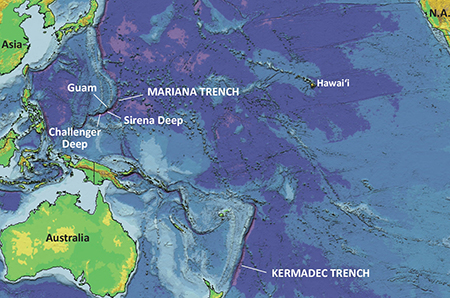Hot Topic – Deep Ocean Sounds
Hot Topic
Scientists Measure Ambient Noise Levels in One of the Deepest Parts of the Global Ocean
The ocean is filled with sound. Sound levels in the ocean differ from location to location and change with time. Some sounds are present more or less everywhere in the ocean all of the time. Some sounds, however, are intermittent and/or only occur in limited regions of the ocean. There are a large number of intermittent sources of sound in the ocean, including those generated by natural physical processes, marine life, and human-made sources. These sounds all contribute to the total background sound in the ocean, which is called ambient noise.For the first time, scientists recently retrieved a hydrophone from the deepest part of the global ocean, the Challenger Deep trough of the Mariana Trench near Micronesia. The hydrophone was deployed as part of a deep-ocean instrument package to a depth of more than 10,971 m (6.71 mi). It continuously recorded deep-ocean ambient sound levels in the 10 to 32,000 Hz range over 23 days. One goal of this project was to establish a baseline for ambient noise in the deepest part of the Pacific Ocean. Future studies will be able to compare their findings against these first recordings to determine if ambient noise levels in this region change.
Scientists were surprised by the variety of natural and anthropogenic sounds the hydrophone system recorded. They expected this deep part of the ocean to be relatively quiet, yet they discovered almost constant noise from both natural and human-made sources. The ambient noise in Challenger Deep was dominated by the sounds of earthquakes (both near and far), shipping, and whale vocalizations. The hydrophone also recorded an acoustic signature associated with a category 4 typhoon that passed through the region.
Sounds recorded in the Challenger Deep
Recording from the challenger deep. The first part has sounds from whales and the second part is an earthquake. The recording has been sped up. Sound clip provided by NOAA/PMEL Acoustics Program.
This is a baleen whale as recorded in the Challenger Deep. The recoding has been sped up. Sound clip provided by NOAA/PMEL Acoustics Program.
This is a ship as recorded in the Challenger Deep. Sound clip provided by NOAA/PMEL Acoustics Program.
Although these baseline recordings are fascinating and important, the development and deployment of a hydrophone that could withstand the pressure forces and other extreme conditions of Challenger Deep is also notable. It took more than six hours for the titanium-encased hydrophone to reach the bottom of the Mariana Trench. Because of the incredible pressure at these depths, scientists had to lower the hydrophone mooring through the water column at no more than five meters per second to be sure the hydrophone, which was made of ceramic material, did not crack. The scientists recovered the hydrophone mooring by sending an acoustic signal from the ship above, triggering its release from the seafloor. Attached floats allowed it to gradually rise to the surface.
Scientists plan to return to Challenger Deep in 2017, when they will deploy another hydrophone for a longer period of time, and also attach a deep-ocean camera.
Watch a video of the hydrophone being retrieved.
Additional Links on DOSITS
- Acoustic Release
- Earthquake
- Hydrophone/Receiver
- Ocean Noise Variability and Noise Budgets
- Ship
- What are common underwater sounds?
